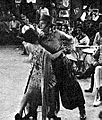Silent film facts for kids
A silent movie is a type of movie that was made without any recorded sound. This means you wouldn't hear people talking, music playing, or sound effects coming from the film itself. Silent movies were popular from the late 1880s until the early 1930s. Back then, cameras couldn't record sound, or the equipment to do so was very new and expensive.

Contents
What Are Silent Movies?
Silent movies tell their stories using actions, facial expressions, and special cards called "intertitles." These intertitles would pop up on screen to show dialogue (what characters were saying) or to explain what was happening in the story.
During a silent movie showing, there was often live music played by an orchestra, a piano player, or even a single organist. This music helped set the mood for the scenes, making them more exciting, sad, or funny. Sometimes, people called "narrators" would even speak during the film to explain things to the audience.
The Silent Era: A Time of Change
The time when silent movies were the main type of film is often called "The Silent Era." This period lasted for about 40 years, from the late 1800s to the early 1930s. It was a very important time for movies because filmmakers were learning how to tell stories visually and how to make special effects.
When sound technology finally became affordable and reliable, movies started to change. The first movies with synchronized sound (where the sound matched the picture) were called "talkies." This new technology quickly made silent movies less popular, and by the mid-1930s, almost all new films had sound.
Famous Silent Movie Stars
Many actors became huge stars during the Silent Era. They had to be very good at acting with their bodies and faces to show emotions without speaking.
- Charlie Chaplin: He was one of the most famous and loved movie stars of the silent era. He often played a character called "The Tramp," a kind-hearted but clumsy fellow with a small mustache, baggy pants, and a cane. Chaplin was not only an actor but also a director and composer.
- Lillian Gish: Known as the "First Lady of American Cinema," Lillian Gish had a very long career in movies, starting in 1912. She was famous for her strong performances and was a leading actress in many important silent films.
- Lon Chaney: Called the "Man of a Thousand Faces," Lon Chaney was amazing at transforming himself into different characters using makeup and costumes. He was known for playing unique and sometimes scary roles.
Popular Silent Films
Even though they don't have sound, many silent movies are still watched and loved today. They are considered classics and show how creative filmmakers were even without modern technology.
Some well-known silent movies include:
- Nosferatu: A Symphony of Terror (1922): A classic horror film about a vampire.
- A Trip to the Moon (1902): One of the very first science fiction films, famous for its imaginative journey to the moon.
- The General (1926): A comedy-action film starring Buster Keaton, known for its amazing stunts.
- Metropolis (1927): A futuristic science fiction movie from Germany, famous for its impressive sets and story.
- The Cabinet of Dr. Caligari (1920): A German horror film known for its unique, twisted, and dreamlike visual style.
Images for kids
-
Charlie Chaplin, widely acclaimed as one of the most iconic actors of the silent era, c. 1919
-
The Horse in Motion, animated from a plate by Eadweard Muybridge, made with an array of cameras set up along a racetrack
-
Roundhay Garden Scene, which has a running time of just over two seconds, was filmed in 1888. It is believed to be the world's earliest surviving motion-picture film. The elderly lady in black is Sarah Whitley, the mother-in-law of filmmaker Louis Le Prince; she died ten days after this scene was filmed.
-
Lillian Gish, the "First Lady of the American Cinema", was a leading star in the silent era with one of the longest careers—1912 to 1987.
-
Lon Chaney (active 1913-1930) was one of the most talented spinet character actors of all time. His unique ability to transform into the most physically grotesque characters earned him the universal name, “Man of a Thousand Faces”.
-
Cinématographe Lumière at the Institut Lumière, France. Such cameras had no audio recording devices built into the cameras.
See also
 In Spanish: Cine mudo para niños
In Spanish: Cine mudo para niños












